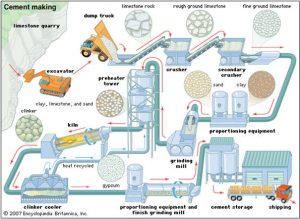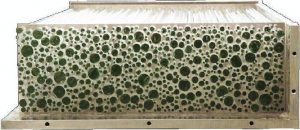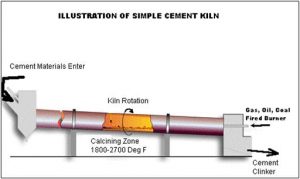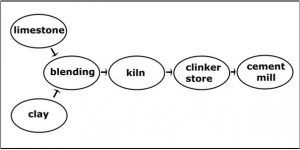What is cement ?
Cement is a binder, a substance that sets and hardens independently, and can bind other materials together. Cement used in construction is characterized as hydraulic (e.g., Portland cement) or non-hydraulic. Hydraulic cements. The most important use of cement is the production of mortar and concrete the bonding of natural or artificial aggregates to form a strong building material that is durable in the face of normal environmental effects. Concrete is a combination of a cement and aggregate.
The sample before filling the spaces with cement
- Advantages of cement
- Cement is used as a binding material
- Cement is easy to handle and apply
- They are suitable to contact with potable water.
- Disadvantages of cement
- Cement are subjected to cracking
- It is very difficult to provide idoneous curing conditions
- Not ideal for situation when settlement is expected.
- Composition of cement
The relative quantities of each of these phases affects:
- setting time
- rate of strength development
- overall strength
- durability
- color
It is important, then, to know the composition of the cement
| Chemical Compound | Percentage |
| Lime, Cao | 60-66 |
| Silica, Sio2 | 17-25 |
| Alumina,Al2O3 | 3-8 |
| Iron Oxide, Fe2O3 | 0.5-6 |
| Magnesia, MgO | 0.5-4 |
| Sulphur trioxide, SO3 | 1-2 |
| Alkalis | 0.5-1.3 |
Four main compounds that are present in cement and percentage of which decides (one of the parameter) the quality of cement are as follows-
- Tricalcium Silcate
- Dicalcium Silicate
- Trialcium Aluminate
- Tetracalcium Alumino Ferrite
- Manufacture of cement
Production process
Cement is typically made from limestone and clay or shale. These raw materials are extracted from the quarry crushed to a very fine powder and then blended in the correct proportions.
The general mining methods are surface mining, while some silicates, such as sand, are commonly mined using dredges, from lakes, rivers and waterways. There are a few underground limestone mines, but most are pits on the surface.
· Cement plants are typically located central to the minerals required to make the cement, which saves the transportation costs and reduces the price of the cement.
· Once the ore material to be used for cement has been mined, it is transported to the crushing/screening plant, where it is crushed and screened, to produce the desired particle size.
· Ore from the mines are typically reduced to about ¾ inch and stored in a coarse stockpile. From there, the ¾ inch ore is typically reduced to a powder in a large ball mill.
· There are two types of cement process,
1. Dry process
2. Wet process
The raw materials are wet ground in the ball mill by adding water, and form a slurry.
· In either event, wet or dry, the ground powder is then blended, using the “Chemist’s Secret Mixture”, which can be a closely guarded “recipe”, and are then transported to the rotary kiln for heat processing.
· In the rotary kiln, first the carbon dioxide is driven off of the calcium carbonates, then the raw material is fused at a temperature somewhere around 2,700 degrees F. The discharge from the kiln is called clinker, as it resembles small rocks or residue from a blast furnace.
. The clinker is the cement in “lump” form. The particle size range for clinker is from about 2 inches (1mm and 25mm across) to about 10 mesh. The clinker is then ground in a ball mill and shipped to users as Portland Cement.
· In its simplest form, the rotary kiln is a tube up to 200 metres long and perhaps 6 metres in diameter, with a long flame at one end. The raw feed enters the kiln at the cool end and gradually passes down to the hot end, then falls out of the kiln and cools down.
Fig2- Illustration of simple cement Kiln
. After cooling, the clinker may be stored temporarily in a clinker store, or it may pass directly to the cement mill. The cement mill grinds the clinker to a fine powder. A small amount of gypsum – a form of calcium sulfate – is normally ground up with the clinker. The gypsum controls the setting properties of the cement when water is added.
Fig 3- The basic components of the cement production process.
 Fig4- Cement production process
Fig4- Cement production process
- Types of cement
Various types of cement are possible by blending different proportions of gypsum, clinker, and other additives. Cements that are used for construction fall into two main categories based on cement properties, hydraulic or non-hydraulic. In addition to the two main cement forms, there are several different forms of hydraulic cement. Of the many varieties of hydraulic cement, the most commonly used cement today is Portland cement.
The 5 types of cement are,
· Type1 – OPC
· Type2 – Moderate heat of hydration (PPC)
· Type3 – rapid hardeneing cement
· Type4 – Low heat cement
· Type5 – Sulphate resisting cement.
Non-Hydraulic Cement
· Non-hydraulic cement is cement which cannot harden while in contact with water, as opposed to hydraulic cement which can.
· Non-hydraulic cements are created using materials such as non-hydraulic lime and gypsum plasters, and oxy chloride, which has liquid properties.
· After non-hydraulic cement is utilized in construction, it must be kept dry in order to gain strength and hold the structure.
· When non-hydraulic cement is used in mortars, those mortars can set only by drying out, and therefore gain strength very slowly.
· Due to the difficulties associated with waiting long periods for setting and drying, non-hydraulic cement is rarely utilized in modern times.
Hydraulic Cement
· Hydraulic cements are cements that have the ability to set and harden after being combined with water.
· As a result of chemical reactions, after hardening hydraulic cement mixtures retain strength and stability even when in contact with water.
· Due to the fact that hydrates that are formed when hydraulic cement is initially in contact with water the new mixture becomes essentially insoluble in water. That gives hydraulic cement a strength and stability that makes it distinct from non-hydraulic cement.
· Hydraulic cement is made primarily from limestone, certain clay minerals, and gypsum, which are burned together in a high temperature process that drives off carbon dioxide and chemically combines the primary ingredients into new compounds.
· Setting and hardening of hydraulic cements is caused by the formation of water-containing compounds, which are formed during reactions between cement components and initial contact with water.
· That reaction produces the hydrates which give hydraulic cement strength and stability.
· As a result of the immediate start of the reactions, stiffening can be observed which is initially slight but which increases with time.
· The compressive strength of the material grows steadily over a period that can range from a few days in the case of ultra-rapid-hardening cements to several years in the case of primitive hydraulic cements.
· The ability to withstand continuous contact with water, in addition to the ability to set and harden quickly, and greater relative strength makes hydraulic cement the main cement utilized in modern day construction.
Portland Cement
· The main form of cement used in construction worldwide today is the hydraulic cement called Portland cement.
· Portland cement is a type of hydraulic cement made by heating a limestone and clay mixture to 1450 °C in a kiln and pulverizing the materials. In a process known as calcination, whereby a molecule of carbon dioxide is liberated from the calcium carbonate to form calcium oxide, or quicklime, which is then blended with the other materials that have been included in the mix.
· The resulting hard substance, called ‘clinker’, is then ground with a small amount of gypsum into a powder to make ‘Ordinary Portland Cement’, the most commonly used type of cement (often referred to as OPC).
· It is a fine, grey or white powder that is made by grinding Portland cement clinker, a limited amount of calcium sulfate which controls the set time, with other minor constituents.
· The cement is used as the basic ingredient of concrete, mortar, stucco and most non specialty grout.
High alumina cement
1. High alumina cement is obtained by fusing or sintering a mixture in suitable proportion of alumina and calcareous material and grinding the resultant product to a fine powder.
2. Raw materials are limestone and bauxite.
3. About 20% of strength is achieved in one day.
Quick Setting Cement
The setting time of ordinary cement is very less if gypsum is not added at the clinkering stage. Therefore when quick setting cement is required, the gypsum is deliberately added in less quantity or not added at all. This type of cement is useful in flowing water and some typical grouting operations.
Tests on Portland, Blended & Hydraulic Cements
- Properties of cement
Chemical Properties
· Chemical analysis
· Compound composition
· Chemical limits
Physical Properties
· Fineness
· Soundness
· Consistency
· Setting time
· False set and flash set
· Compressive strength
· Heat of hydration
· Loss on ignition
· Density
· Bulk density
· Sulfate expansion
- Tests for cement
a) Fineness Test-
The fineness of cement can be defined as the measure of size of particles of cement or in simple form “Specific Surface of Cement”. This test is usually carried out using IS sieve no.9 or 90 microns.
b) Setting Time Test-
Cement when mixed with water triggers a process which results in a hardened mass of mixture wherein hardness gradually increases with time. There are two setting times for cement- Initial Setting Time (IST) or Final Setting Time (FST).It is tested using Vicat’s Apparatus.
Eg. For Portland Cement IST is around 30 mins and FST is around 600 mins.
A) INITIAL SETTING TIME
Place the test block under the rod bearing the needle. Lower the needle gently in order to make contact with the surface of the cement paste and release quickly, allowing it to penetrate the test block. Repeat the procedure till the needle fails to pierce the test block to a point 5.0 ± 0.5mm measured from the bottom of the mould. The time period elapsing between the time, water is added to the cement and the time, the needle fails to pierce the test block by 5.0 ± 0.5mm measured from the bottom of the mould, is the initial setting time.
B)FINAL SETTING TIME
Replace the above needle by the one with an annular attachment. The cement should be considered as finally set when, upon applying the needle gently to the surface of the test block, the needle makes an impression therein, while the attachment fails to do so. The period elapsing between the time, water is added to the cement and the time, the needle makes an impression on the surface of the test block, while the attachment fails to do so, is the final setting time.


Fig 5- Testing Normal Consistency of Cement
Fig 6- Hand mixing concrete, testing hand mixed concrete
c) Strength Test-
The strength of cement is defined in MPa or N/mm2. For grade 33 Portland cement, strength should be around 33MPa in 28 days. Compression test is carried out to check the strength of cement.
Fig 7- Compressive strength testing machine
d) Soundness Test-
Soundness of cement can be defined as a process in which cement does not show any considerable change in volume after setting. Autoclave tests and Le Chateleir tests care carried out to check the soundness of cement.
Fig 8- Le Chatelier Moul
e) Heat of Hydration Test-
The heat of hydration can be defined as heat from cement paste liberated as a reaction of water with cement. This test is usually carried out in thermos flask.
f) Chemical Composition Test-
A test is carried out on cement that tests the ratio of chemicals in the cement. Different standards and codes specify different value of such ratios.








